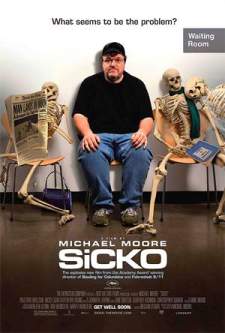|
|
|
March 8th, 2008 by Miki Saxon
Healthcare providers’ attitudes towards money often make my blood boil. It’s not just insurance and drug companies and hospitals, but the financial institutions that buy the debt of the un/under insured and then charge exorbitant interest rates on it.
Of course, it’s all excused in the name of capitalism and keeping investors happy, while their advertising presents them as caring, do-the-right-thing organizations wrapped in concern for the well-being of their customers.
 Obviously it’s the former that ratifies their practice of charging for errors. Obviously it’s the former that ratifies their practice of charging for errors.
Hopefully it’s starting to change. “Since last fall, hospitals in 11 states have agreed to waive fees for certain rare errors dubbed “never events” because safety experts say they should never happen at all.”
But only 28 events make the grade—here are the top five.
- Surgery on the wrong body part.
- Surgery on the wrong patient.
- Wrong surgical procedure performed on a patient.
- Object left in patient after surgery.
- Death of patient who had been generally healthy during or immediately after surgery for a localized problem.
Discharging an infant to the wrong person is way down at number nine.
So what’s the cost?
“In 2006, Medicare was billed 764 times for objects left behind after surgery, resulting in an average payment of nearly $62,000 per event [$47,368,000]. The agency was billed 33 times for patients who got the wrong blood, at an average cost of $46,000 apiece [$1,518,000], and nearly 323,000 times for the worst kind of pressure ulcers, a preventable problem, at a cost of $40,381 [$13,043,063,000] apiece.”
Read the articles and make up your own mind.
If your blood boils send them to your State and Federal Congress people.
If it doesn’t I’d love to hear why not.
Your comments—priceless
Don’t miss a post, subscribe via RSS or EMAIL
Posted in Ethics, Healthcare, Politics, What Do You Think?, What Leaders DON'T |
2 Comments »
Sphere: Related Content
*/?>
March 7th, 2008 by Miki Saxon
 If you haven’t heard it already, here’s a story guaranteed to make you think at least twice before opting for any kind of avoidable surgery or hospital stay. If you haven’t heard it already, here’s a story guaranteed to make you think at least twice before opting for any kind of avoidable surgery or hospital stay.
“…hospital-acquired infections that kill nearly 100,000 people in the U.S. each year, according to federal estimates.”
That’s a very large number, especially when the top culprits are, “Doctors, nurses and other hospital staffers too busy, too distracted — or, sometimes, too arrogant — to wash [their hands].”
Can you even remember at what age your mom started the “wash your hands” ritual? Not to mention all the germ-killing products ads we’re inundated with daily.
How bad is it?
“At best, hospital staffers wash adequately about half the time…” Still worse, “some hospitals post hand hygiene rates as low as 20 percent when they start tracking the problem…”
While a 50% voter turnout is something to cheer, 50% adequate hand-washing, let alone 20%, is the stuff of nightmares.
And did you notice the qualifier ‘adequate’?
“National guidelines say they’re supposed to use alcohol-based hand rubs or soap and warm water for at least 15 seconds before and after every direct contact with a patient, with excretions, or with contaminated surfaces or objects,” moreover, that includes when they’re wearing gloves—strip the gloves and wash.
Of course, the information that washing reduces infections has only been around since 1846, so maybe it hasn’t had time to spread.
“…an August study in the journal Pediatrics that showed that boosting hygiene rates cut hospital-acquired infections by 60 percent in more than 1,000 tiny newborns at a children’s hospital in Switzerland,” and that was with a lousy 13% hand hygiene improvement!
According to Dr. Robert Wise, vice president of standards and survey methods for the Joint Commission, a national hospital accrediting agency, “there aren’t a lot of ways to measure compliance.”
Considering the rise of drug-resistant germs, such as MRSA (Methicillin-resistant Staphylococcus aureus), your best bet if you or someone you care about is hospitalized is to have someone who’s conscious available and always ask your provider to wash—be it your doctor, surgeon, a nurse or someone else.
Keep in mind that this applies just as much to doctor and dentist office visits, lab tests (I still remember ten years ago when I was in San Francisco and the tech refused to wear gloves when she went to draw my blood—needless to say I asked for and got another tech.) or any other setting.
Tomorrow I return to money—a healthcare subject near to all our hearts.
Have you had to ask someone to wash?
Would you?
Your comments—priceless
Don’t miss a post, subscribe via RSS or EMAIL
Posted in Ethics, Healthcare, Politics, What Leaders DON'T |
6 Comments »
Sphere: Related Content
*/?>
March 6th, 2008 by Miki Saxon
On the heels of Tuesday’s post I came to realize that every time I write about anything to do with healthcare I find more stuff that makes me want to scream and throw a tantrum. Rather than doing that (it upsets my cats and neighbors) I thought I’d let the steam off here.
I’ll start with a Forbes article (mentioned Monday on Project Management 411) focusing on the effect of corporate salespeople on healthcare costs. 
No surprise if you think of cause and effect—I sell you equipment and to justify the cost you push the service that it performs, which enables me to sell you a replacement version more quickly. Here’s the example Forbes gave.
“Radiologist David Gruen used to spend millions of dollars to replace his General Electric (it could just as well have been Siemens or Phillips) MRI and CT scanners every three years. It was money well spent because the machines were always busy…” but now he waits five years and the poor doctor had to take a 20% salary cut.
What happened?
“A year ago Medicare cut the price it pays for imaging, so Gruen gets paid 15% to 50% less for each order, depending on the type of scan. Health insurers got wise, too, and started imposing a 48-hour review on imaging orders. The doctor hired clerks to battle the HMOs, but his office volume was flat last year, down from 10% growth in prior years.“
Granted “Imaging accounts for only 5% of the $2 trillion in U.S. medical spending, but it has been the fastest-growing component of health care inflation in recent years, climbing 20% annually until last year,” but everybody wants one. Scanning businesses offer specials and run sales just as other consumer products do.
Of course, the drug companies are doing the same thing, “Today drugs are promoted in much the same way as other products. Drug companies devote forty percent of their advertising expenditures — over $4 billion per year — to DTC [direct-to-consumer] ads. The average American views as many as 16 hours of prescription drug ads per year…”
DTC ads are under Congressional review and has been framed as a free speech issue by the drug companies.
I understand that medical products and drugs are businesses and that as businesses they focus on profit in order to keep Wall Street happy—happy Wall Street = rising stock = happy investors—but at what cost to the future of this country?
Come back tomorrow for my take on the dirtiest little secret in medicine.
What are your views on DTC drug and medical procedure ads?
Your comments—priceless
Don’t miss a post, subscribe via RSS or EMAIL
Posted in About Leadership, Ethics, Healthcare, Leading Factors, Politics, What Do You Think? |
No Comments »
Sphere: Related Content
*/?>
February 16th, 2008 by Miki Saxon
The difficulty of getting an appointment to see your doctor (wait time) is the bogyman thrown up to defeat universal healthcare, but the statistics don’t back that up. According a Business Week article citing a study by the Commonwealth Fund,“If you find a suspicious-looking mole and want to see a dermatologist, you can expect an average wait of 38 days in the U.S., and up to 73 days if you live in Boston…a knee injury… the average time needed to see an orthopedic surgeon ranges from 8 days in Atlanta to 43 days in Los Angeles. Nationwide, the average is 17 days.”… only 40% of U.S. doctors have arrangements for after-hours care, vs. 75% in the rest of the industrialized world… 51% of sick Americans surveyed did not visit a doctor, get a needed test, or fill a prescription within the past two years because of cost. No other country came close.”
In the Washington Monthly Kevin Drum cites the BW article and also mentions that “…the numbers are inflated because we don’t count the people who can’t get nonemergency surgery [such as hip replacements] because they’re uninsured…,” while the comments left by readers put real stories to the statistics.
Not all physicians are against a universal health program, which is smart since many Americans of more modest means are traveling in order to off-shore their healthcare needs—surgical and otherwise.
“Gary Hulmes, a furniture store manager from Florida who went to New Delhi to have spinal surgery done and paid a total of $9,000 including airfare, a five-day hospital stay, and a total stay of three weeks in India (with some sightseeing thrown in). If performed in a US hospital, the same procedure would have cost $36,000 – 50,000.”
In Europe healthcare is measured, evaluated and reported publicly by Health Consumer Powerhouse Euro Health Consumer Index 2007.
The report makes for interesting reading.
“All the 27 EU members are of course included in this year’s index as well as Switzerland and Norway.”
‘The 2007 Index is, just like in 2006, built up as a “pentathlon”, with indicators grouped in five sub-disciplines. After having had to surrender to the “lack of statistics syndrome”, and after scrutiny by our expert panels, 27 indicators survived into the EHCI 2007.
The indicator areas for the EHCI 2007 thus became:
Sub-discipline Number of indicators
- Patient rights and information 9
- Waiting time for treatment 5
- Outcomes 5
- “Generosity” 4
- Pharmaceuticals 4″
Dr. David J. Brailer is point man on the Administration’s “…effort to remake the $1.9 trillion U.S. health-care business by using information technology to save money and lives…Paying for the network will be the first major hurdle. Many cash-strapped hospitals and small-practice doctors have no interest in footing the bill for a medical Internet. One key reason is the mismatch between costs and savings: While health-care providers bear the cost of tech investments, Medicare and private insurers reap almost all the savings.”
Then, of course, there are all those cute, educational consumer ads for drugs to help things along.
Of course, any discussion of healthcare wold be incomplete without some reference to the insurance industry. An industry, to my mind, far more committed to executive compensation and investor profits than service to its policy holders. Rather than add to the thousands of commentary already out there, I thought I’d leave you with a visual that, to me, says it all.
So what comes first?
Finding a way to pay for healthcare or knowing what we’re paying for?
Would the money being spent on pork and corporate subsidies be better spent on healthcare for all Americans?
If not, should the companies that currently pay no, or little, tax be the focus as opposed to small business?
What do you think should/can be done to fix this mess?
Your comments—priceless
Don’t miss a post, subscribe via RSS or EMAIL
Posted in About Leadership, Ethics, Healthcare, Leading Factors, Politics, What Do You Think? |
6 Comments »
Sphere: Related Content
*/?>
February 15th, 2008 by Miki Saxon
Matt Weeks has held various management positions in the financial services/banking industry, started, ran and sold a small business, ran a successful consulting practice and currently is CEO/founder of stealth mode startup eyeTmedia.
“The idea of some sort of assessment or tax on businesses to fund health care for those citizens who are otherwise not covered is a bad idea.
While I agree that ER room medicine is not smart preventative, wellness-based medicine and is not good social or fiscal policy, we have to find a different approach other than force-funding it on the back of business. And take note, it will primarily fall on small businesses.
Most of the businesses in our Great Country are “small businesses.” When I was at Intuit, makers of QuickBooks, Quicken and TurboTax, my team launched the Online Payroll Service. In the course of understanding what our customers wanted, we discovered that most of the “small business” enterprises were in fact sole proprietors, or very small companies with fewer than six employees, counting the owner(s).
Now let’s reconcile that fact (check with the SBA and DOL -Department Of Labor) with the other reality that most “workers” in The United States are employed at these small businesses. Not huge corporations. Thus the main “driver” of employment as well as productivity in the country are these small businesses.
One final step: If we believe the Fed, when they tell us that the driver of our economy is spending in the retail sector, then we must look directly to the bulk of the employees and their families for that spend, presumably coming from disposable income. So it is circular, as the small business employees spend their disposable income at other small businesses. Thus we still live in villages to a greater extent than we may believe.
However, small businesses have a devil’s bargain. If they are burdened with an additional expense in the form of a tax or assessment (like an extra payroll tax), they will have to lay off employees, or drastically reduce their pay, or their pay increases, absent some dramatic increase in productivity or other business growth. I cannot connect the dots between less cash in the company and dramatic growth. Less cash is not a driver of business health and expansion.
So the net effect of this well-intentioned but ill-thought-through idea will be less cash in the economy, lower net wages for employees, and questionable coverage, which is not mapped-out.
You might say that this will not impact these “small businesses” and that we’ll focus on the large businesses. The problem here is that those large businesses that do not already provide a reasonably sensible benefits package are, by definition, stingy and mean-spirited. They are unlikely to have some epiphany about “doing the right thing” and are more likely to just move offshore. As in moving all the jobs they can move offshore. Not a good thing either. That just leaves us with fewer employed people to pay for this whole idea.
So large companies who are bad actors are not likely to be the source of this cash (and will likely cut and run), and the bulk of employees in the country who work for small businesses are likely to be in even more pain if their companies are forced to make meaningful payments to some centrally managed health care superfund. And who among us believe that such a superfund will be efficient or effective?
So I say “yes” we need to approach the problem, and keep the value of covering the non-covered. I just suggest thinking it through a bit more. Many people think “business” is the big bad corporation. In fact, our economy is based on small businesses, and perhaps the only true ethical accountability for “doing the right thing” exists there, at the local, in-person level. Let’s dig a bit deeper and find a more effective approach.
It’s a hard problem. I don’t have answers… But I do know that a blanket “tax” or “assessment” on a monolithic “business” category is wrong-headed and overly simplistic given the complexity of the problem.”
Does the US really need to raise taxes to fund healthcare or is the money actually there, but being incorrectly spent via pork, earmarks, etc.?
Your comments—priceless
Don’t miss a post, subscribe via RSS or EMAIL
Posted in About Leadership, Healthcare, Leading Factors, Politics, What Do You Think? |
2 Comments »
Sphere: Related Content
*/?>
February 14th, 2008 by Miki Saxon
The next response is from Al Negrin, a retired CEO whose career ran the gamut from giant multinationals to startups.
 “First of all, to provide a social safety net of the type most European and Scandinavian countries do, it is necessary to increase taxes on both businesses and individuals. This of course is a disincentive for both aggressive managements and aggressive employees. Why work hard to further your company’s prospects or your own prospects when any gains are largely taken away in taxes? “First of all, to provide a social safety net of the type most European and Scandinavian countries do, it is necessary to increase taxes on both businesses and individuals. This of course is a disincentive for both aggressive managements and aggressive employees. Why work hard to further your company’s prospects or your own prospects when any gains are largely taken away in taxes?
That’s why European companies are large, stable and slow moving, and European employees are satisfied to live a middle class existence without fighting to achieve higher paid positions and prefer to balance work and family by taking 5 weeks vacation every year. Election after election has shown this social position is favored by the electorate all throughout Europe (except in the UK).
The United States has achieved the pre-eminent world economy by taking a contrary social position. I don’t see that we want to give up aggressive business and personal challenge by converting to an all-embracing social safety net. That said, however, the Constitution provides that the government shall be empowered to “promote the general welfare.” Having tens of millions of citizens without access to appropriate health care is not “providing for the general welfare.” Thus I favor some sort of universal health care, without however extending it so far as to impede personal or ” business incentivization.”
Do you think that some form of universal healthcare
is possible in the US?
Your comments—priceless
Don’t miss a post, subscribe via RSS or EMAIL
Posted in About Leadership, Healthcare, Leading Factors, Politics, What Do You Think? |
7 Comments »
Sphere: Related Content
*/?>
February 12th, 2008 by Miki Saxon
I constantly hear people say that they’d like what Europe has, but don’t want to pay the increased taxes, business or individual, necessary to provide it.I asked a friend who lives there and she says that it’s not that simple.
She explained that in fact, taxation in the US is higher in absolute terms, Healthcare costs are one of the highest costs for a US employer, but are ignored in terms of taxation.
She says that when considering Europe’s taxes you need to consider that in Europe no business pays healthcare.
From an individual perspective, no one pays for health or for education, including higher education.
Of course, many US corporations, such as GE, pay little to no taxes anyway.
“Eighty-two of the 275 companies, almost a third of the total, paid zero or less in federal income taxes in at least one year from 2001 to 2003.
In the years they paid no income tax, these companies earned $102 billion in pretax U.S. profits. But instead of paying $35.6 billion in income taxes as the statutory 35 percent corporate tax rate seems to require, these companies generated so many excess tax breaks that they received outright tax rebate checks from the U.S. Treasury, totaling $12.6 billion (see box). These companies’ “negative tax rates” meant that they made more after taxes than before taxes in those no-tax years.”
Then, late last night I received the following email. The sender is an executive with a major insurance company. He apologized for requesting anonymity, but said that his comments could cost him his job.
I think what he offers is of vital importance to this discussion.
“Firstly, increasing tax on business is obfuscation of the issue. Providing universal healthcare is a question of prioritizing the enormous tax revenues that the government receives. We can choose to prioritize healthcare and education, or we can prioritize military spending that makes it difficult to do business internationally at the tune of $18 billion per month.
Now, it is clear that the level of taxation in the US is not significantly lower than in countries that have universal healthcare. What differs is that healthcare costs are significantly higher per capita in the US than in all other nations. In addition, the results of healthcare in the US, as measured by infant mortality or life expectancy, is lower than in all comparable nations. Infant mortality and life expectancy is as low as former Soviet republics such as Latvia or Slovenia. It cannot compare with Western Europe, Canada or developed Asian nations. Clearly, since the costs in the US are higher than in any comparable nation and results are lower, it is possible to both improve healthcare for all Americans while reducing the expense. This, however, will affect the profits of very powerful interests.
Rather than focusing the discussion of taxes, maybe we should focus the conversation on why it costs more to deliver less in the US.”
I think that focusing this discussion on who pays may be missing the boat. Maybe along with who pays we need to look at what we’re paying for and why it costs so much. What do you think?
Your comments—priceless
Don’t miss a post, subscribe via RSS or EMAIL
Posted in About Leadership, Healthcare, Leading Factors, Politics, What Do You Think? |
2 Comments »
Sphere: Related Content
*/?>
February 11th, 2008 by Miki Saxon
 Healthcare is on everybody’s mind these days. In a recent conversation I had with KG Charles-Harris, CEO of startup Emanio, we touched on the possibility of a tax increase on business to fund health care. Healthcare is on everybody’s mind these days. In a recent conversation I had with KG Charles-Harris, CEO of startup Emanio, we touched on the possibility of a tax increase on business to fund health care.
KG said, “It’s clear that the US healthcare situation needs to be improved. However, there are so many different views as to how we may improve healthcare, that the HOW question is completely open. Is increasing taxes the best way of doing it? Or is reforming the system better? America is a great country and we must as a great country do what’s necessary for our people. However, I am unsure that increasing taxes is the best way of doing this.”
In his column, Paul Krugman credits John Edwards for “introducing bold policy proposals — and they were met with such enthusiasm among Democrats that his rivals were more or less forced to follow suit…Edwards plan…giving people the choice of staying with private insurers, while also giving everyone the option of buying into government-offered, Medicare-type plans — a form of public-private competition…”
For the rest of this week (or longer) I’m going to post commentary from business people I know. I asked this question, “Should the US increase taxes on businesses in order to provide universal health care for its citizens as other countries have done?”
I suggested that they look at the question broadly—not just the tax issue—and from whatever prospective they chose.
I’m hoping that you will weigh in also. If you feel your response is more a full post than a comment email it to me along with a short introduction and I’ll give it post status—as long as it’s not just a blatant political statement.
Is healthcare an important issue to you?
Your comments—priceless
Don’t miss a post, subscribe via RSS or EMAIL
Posted in About Leadership, Healthcare, Leading Factors, Politics, What Do You Think? |
10 Comments »
Sphere: Related Content
*/?>
January 23rd, 2008 by Miki Saxon
Posted in Wordless Wednesday |
6 Comments »
Sphere: Related Content
*/?>
April 6th, 2020 by Miki Saxon
 I received the following email from a longtime reader. I received the following email from a longtime reader.
Hey Miki, I read a lot of conflicting information about Covid-19 and I was wondering if you or your contacts had anything to add, whether good or bad.
I don’t feel qualified to comment much, so I reached out to see what more knowledgeable people I know had to say.
One detailed response I thought worth sharing accurately reflects my gut reaction, which was based on nothing more than my growing cynicism.
His, on the other hand, are based on an in depth knowledge of current events, finance and the economy.
The author is a senior guy working on Wall Street. It’s anonymous because he would probably be fired, since his company is close to the powers-that-be, and his opinion and comments are at variance with what they are saying.
I am significantly less optimistic than most people I speak with. However, I believe that the numbers we’re receiving are highly skewed by low testing numbers.
Despite having 3+ months to prepare, we’re caught completely unprepared. Our government has bungled the response in more ways than I can mention. I have 2 siblings in Miami who are health workers, one a surgeon who happens to be professor of surgery and chief surgeon. They are now dressing in plastic bags and going into surgery with bandanas covering their faces instead of masks. It seems to be the same in LA and SF.
The US has about 50 million people without access to healthcare, about 11 million of which are undocumented immigrants. These represent a hidden and significant risk factor that is largely ignored by media and most people in discussing the problem. The US is the only OECD country with this risk factor in such significant numbers. We also do not have a well-functioning primary health system. It means that we essentially do not know how disease is developing in the populace and are unable to devise strong strategies for addressing a pandemic like this (not to mention that the president fired the pandemic response team in 2018).
In China it took 3-4 months to stop the pandemic, and based on recent news past patients are being reinfected. It means that we will be out of this at earliest in another 2-3 months.
There is a significant risk for a 1918 Spanish Flu situation where there was a first wave that was somewhat virulent, but nowhere close to the second wave that came the following autumn that killed up to 6% of the world population. It lasted from January 1918 until December 1920, so this can last for more time than we’re expecting and be worse than we’re now seeing.
However, if we look at the numbers from Germany, which is the only nation that is attempting to test major portions of the population, the mortality rates are well below what we’re seeing elsewhere. This is very hopeful, especially when other numbers seem so bleak.
In China there are at least 5 different strains, and in Iceland they have identified up to 40. This means that it is mutating in different directions. The US response, which is more akin to that taking place in Kenya and Equador than most of the OECD, may have both a positive and negative consequence. It may create herd immunity, while also having a significantly higher mortality rate prior to this happening.
So, to stop my rambling, here are my recommendations:
-
- be conservative in all ways with regard to hand washing, mask wearing, having outside vs. inside footwear, disinfecting doorknobs/light switches, etc.,
- plan for longer time frames of sequestration than the authorities advocate,
- avoid contact with health workers of all types, unless you suspect serious COVID symptoms,
- stock food that lasts, especially frozen vegetables, etc., that give your immune system the ability to function at optimum capacity.
Beyond these immediate health issues, there is a probability for recession/depression, especially considering that the US is consumer driven economy (vs. export or manufacturing driven). Consumers are losing jobs wholesale, and while the Fed is printing money like never before, monetary policies will have limited success considering the record low interest rate. In addition, we still have not addressed the “toxic sludge” from the last recession.
Image credit: EpicTop10.com
Posted in Personal Growth |
No Comments »
Sphere: Related Content
*/?>
|
 Subscribe to
Subscribe to
MAPping Company Success
About Miki 
Clarify your exec summary, website, etc.
Have a quick question or just want to chat? Feel free to write or call me at 360.335.8054
The 12 Ingredients of a Fillable Req
CheatSheet for InterviewERS
CheatSheet for InterviewEEs™
Give your mind a rest. Here are 4 quick ways to get rid of kinks, break a logjam or juice your creativity!
Creative mousing
Bubblewrap!
Animal innovation
Brain teaser
The latest disaster is here at home; donate to the East Coast recovery efforts now!
Text REDCROSS to 90999 to make a $10 donation or call 00.733.2767. $10 really really does make a difference and you'll never miss it.
And always donate what you can whenever you can
The following accept cash and in-kind donations: Doctors Without Borders, UNICEF, Red Cross, World Food Program, Save the Children
*/
?>About Miki
About KG
Clarify your exec summary, website, marketing collateral, etc.
Have a question or just want to chat @ no cost? Feel free to write
Download useful assistance now.
Entrepreneurs face difficulties that are hard for most people to imagine, let alone understand. You can find anonymous help and connections that do understand at 7 cups of tea.
Crises never end.
$10 really does make a difference and you’ll never miss it,
while $10 a month has exponential power.
Always donate what you can whenever you can.
The following accept cash and in-kind donations:
|
 Obviously it’s the former that ratifies their practice of charging for errors.
Obviously it’s the former that ratifies their practice of charging for errors.



 If you haven’t heard it already, here’s a
If you haven’t heard it already, here’s a 

 “First of all, to provide a social safety net of the type most European and Scandinavian countries do, it is necessary to increase taxes on both businesses and individuals. This of course is a disincentive for both aggressive managements and aggressive employees. Why work hard to further your company’s prospects or your own prospects when any gains are largely taken away in taxes?
“First of all, to provide a social safety net of the type most European and Scandinavian countries do, it is necessary to increase taxes on both businesses and individuals. This of course is a disincentive for both aggressive managements and aggressive employees. Why work hard to further your company’s prospects or your own prospects when any gains are largely taken away in taxes?  Healthcare is on everybody’s mind these days. In a recent conversation I had with KG Charles-Harris, CEO of startup
Healthcare is on everybody’s mind these days. In a recent conversation I had with KG Charles-Harris, CEO of startup 
 I received the following email from a longtime reader.
I received the following email from a longtime reader.
